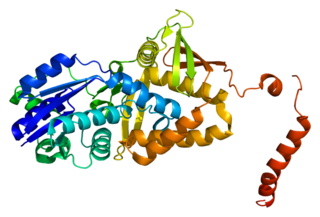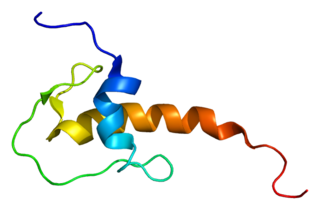
The organic compound citrulline is an α-amino acid. Its name is derived from citrullus, the Latin word for watermelon. Although named and described by gastroenterologists since the late 19th century, it was first isolated from watermelon in 1914 by Japanese researchers Yotaro Koga and Ryo Odake and further codified by Mitsunori Wada of Tokyo Imperial University in 1930. It has the formula H2NC(O)NH(CH2)3CH(NH2)CO2H. It is a key intermediate in the urea cycle, the pathway by which mammals excrete ammonia by converting it into urea. Citrulline is also produced as a byproduct of the enzymatic production of nitric oxide from the amino acid arginine, catalyzed by nitric oxide synthase.

Keratin, type I cytoskeletal 4 also known as cytokeratin-4 (CK-4) or keratin-4 (K4) is a protein that in humans is encoded by the KRT4 gene.

Keratin 16 is a protein that in humans is encoded by the KRT16 gene.

A disintegrin and metalloproteinase with thrombospondin motifs 2 (ADAM-TS2) also known as procollagen I N-proteinase is an enzyme that in humans is encoded by the ADAMTS2 gene.

Uroporphyrinogen III decarboxylase is an enzyme that in humans is encoded by the UROD gene.

Citrullination or deimination is the conversion of the amino acid arginine in a protein into the amino acid citrulline. Citrulline is not one of the 20 standard amino acids encoded by DNA in the genetic code. Instead, it is the result of a post-translational modification. Citrullination is distinct from the formation of the free amino acid citrulline as part of the urea cycle or as a byproduct of enzymes of the nitric oxide synthase family.

Uncombable hair syndrome (UHS) is a rare structural anomaly of the hair with a variable degree of effect. It is characterized by hair that is silvery, dry, frizzy, wiry, and impossible to comb. It was first reported in the early 20th century. It typically becomes apparent between the ages of 3 months and 12 years. UHS has several names, including “pili trianguli et canaliculi,” “cheveux incoiffables,” and “spun-glass hair.” This disorder is believed to be autosomal recessive in most instances, but there are a few documented cases where multiple family members display the trait in an autosomal dominant fashion. Based on the current scientific studies related to the disorder, the three genes that have been causally linked to UHS are PADI3, TGM3, and TCHH. These genes encode proteins important for hair shaft formation. Clinical symptoms of the disorder arise between 3 months and 12 years of age. The quantity of hair on the head does not change, but hair starts to grow more slowly and becomes increasingly “uncombable.” To be clinically apparent, 50% of all scalp hair shafts must be affected by UHS. This syndrome only affects the hair shaft of the scalp and does not influence hair growth in terms of quantity, textural feel, or appearance on the rest of the body.

Protein-glutamine gamma-glutamyltransferase K is a transglutaminase enzyme that in humans is encoded by the TGM1 gene.

In enzymology, a protein-arginine deiminase (EC 3.5.3.15) is an enzyme that catalyzes a form of post translational modification called arginine de-imination or citrullination:

Argininosuccinate synthetase is an enzyme that in humans is encoded by the ASS1 gene.

Protein-arginine deiminase type-4, is a human protein which in humans is encoded by the PADI4 gene. The protein as an enzyme, specifically protein-arginine deiminase, a type of hydrolase.

Glycine amidinotransferase, mitochondrial is an enzyme that in humans is encoded by the GATM gene.

Lympho-epithelial Kazal-type-related inhibitor (LEKTI) also known as serine protease inhibitor Kazal-type 5 (SPINK5) is a protein that in humans is encoded by the SPINK5 gene.

Protein-arginine deiminase type-2 is an enzyme that in humans is encoded by the PADI2 gene.

Peptidyl arginine deiminase, type I, also known as PADI1, is a protein which in humans is encoded by the PADI1 gene.

Calmodulin-like protein 5 is a protein that in humans is encoded by the CALML5 gene.

Keratin, type II cytoskeletal 78 is a protein that in humans is encoded by the KRT78 gene.

Protein arginine N-methyltransferase 6 is an enzyme that in humans is encoded by the PRMT6 gene.

Peptidyl-prolyl cis-trans isomerase G is an enzyme that in humans is encoded by the PPIG gene.

Trichohyalin is a protein that in mammals is encoded by the TCHH gene.




















